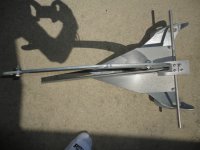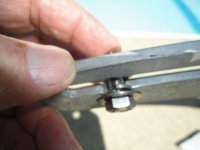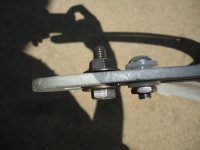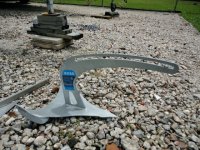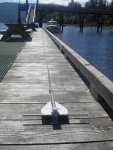The Boss 10# was ordered to see if it would be a satisfactory anchor for the C Dory 22. The fluke area is slightly more than the Manson Supreme 15# anchor, and about 50% larger than the Delta 14 we are currently using for primary anchor, and the Guardian 7/Fortress 6 Anchors we are using for back up bow anchors and primary stern anchors.
The goal is a lighter anchor to bring up (we do not have a windlass), and with the slot, which moves the attachment point toward the crown of the anchor, we can "trip" the anchor rather than breaking it out, hopefully the sand and mud will fall off as the anchor comes up, thus a lighter load on our backs.
Jay noted that there were some cosmetic issues (and we hope not structural) which we would not expect for this expensive an anchor. (He bought a 25 lb Manson Boss for his C Dory 22.).
The tables provided by Manson show that the 10 # is recommended for 15 to 22 foot boats, so we are at the upper margin for this size anchor. The 25 lb is rated for 25 to 35 foot boats. In comparison the Delta 14 is rated for 21 to 31 foot boats, and the Guardian/Fortress 7 is rated for 28 to 33 foot boats--and the Boss 10 lb has a larger fluke area than either of these two anchors by about 40%. (By direct overlay comparison).
I am not advocating that a steel anchor which weighs 10 lbs is as good as an aluminum design which actually weighs 7 lbs, or the well respected Delta Fast Set. For our "storm anchor" on the C Dory 22, we have an FX 37, left over from a larger boat, and rated for 38 to 51 foot boat or a HT steel anchor of about 50 lbs.
The Boss anchor is made of 800 mpa high tensile steel, which is the same as used in the Manson Supreme, but is not guaranteed against bending! My primary concern is that the weld of the shank to the fluke is the weakest point of the entire system. However, the weld on my anchor seems to be well done.
Here some photos and comments:
First side by side the Manson Boss, next to the Guardian 7, and the Delta 14 on the bow of the boat. The shank of the Boss 10 will fit into the standard roller, almost exactly as this Delta does.
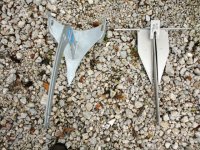
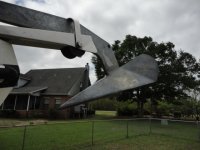
Next some views of the Boss 10 as it would most likely land on the seabed. You can see that it will immediately begin to dig in with either position.
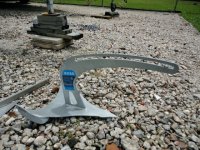
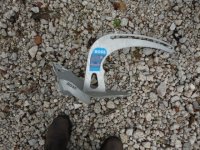
Some details of the Boss: First the Ears, and note that the welding is not a nice perfect seam--probably not structural, but as Jay, I would expect better for an expensive anchor. And the mud or water relief holes:
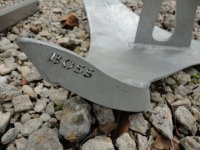
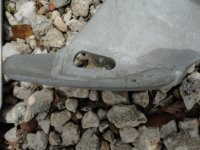
Now the most controversial part of the Boss: The keeper or "shackle preventer" which prevents the shackle to the rode from sliding down the shank slot to trip the anchor. It is made of a plastic (probably Durilon). I had expected a metal--the bolt is only 1/4"--although this will be in compression, I will feel better with a 1/2" SS bolt in this place--and also using some such as a Nylox, if I am not going to slide the shackle down the shank. Also this requires shackles, as many anchoring systems do.
The second photo is of the plate welded to the bottom. This comes back to the where the shank is welded on--and is plenty thick. I speculate that the plates were welded together, with a smaller plate about 3/8" thick under the base fluke. Then the weld ground to conformity and a taper to both sides and point of the fluke. Finally the anchor was galvanized.
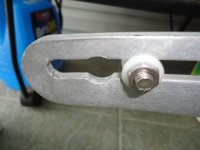
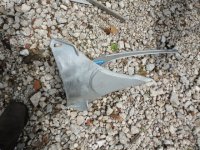
The metal thickness: Shank is just under 1/4" @ 0.247", the bottom plate is 0.167, and the point where the second plate is welded in place is 0.575".
The real "test" will be in a week or so, when we hook up the 140 HP Suzuki on the Caracal, and see how much this anchor moves, and compares to the Delta Fast Set and Guardian 7.
The goal is a lighter anchor to bring up (we do not have a windlass), and with the slot, which moves the attachment point toward the crown of the anchor, we can "trip" the anchor rather than breaking it out, hopefully the sand and mud will fall off as the anchor comes up, thus a lighter load on our backs.
Jay noted that there were some cosmetic issues (and we hope not structural) which we would not expect for this expensive an anchor. (He bought a 25 lb Manson Boss for his C Dory 22.).
The tables provided by Manson show that the 10 # is recommended for 15 to 22 foot boats, so we are at the upper margin for this size anchor. The 25 lb is rated for 25 to 35 foot boats. In comparison the Delta 14 is rated for 21 to 31 foot boats, and the Guardian/Fortress 7 is rated for 28 to 33 foot boats--and the Boss 10 lb has a larger fluke area than either of these two anchors by about 40%. (By direct overlay comparison).
I am not advocating that a steel anchor which weighs 10 lbs is as good as an aluminum design which actually weighs 7 lbs, or the well respected Delta Fast Set. For our "storm anchor" on the C Dory 22, we have an FX 37, left over from a larger boat, and rated for 38 to 51 foot boat or a HT steel anchor of about 50 lbs.
The Boss anchor is made of 800 mpa high tensile steel, which is the same as used in the Manson Supreme, but is not guaranteed against bending! My primary concern is that the weld of the shank to the fluke is the weakest point of the entire system. However, the weld on my anchor seems to be well done.
Here some photos and comments:
First side by side the Manson Boss, next to the Guardian 7, and the Delta 14 on the bow of the boat. The shank of the Boss 10 will fit into the standard roller, almost exactly as this Delta does.


Next some views of the Boss 10 as it would most likely land on the seabed. You can see that it will immediately begin to dig in with either position.


Some details of the Boss: First the Ears, and note that the welding is not a nice perfect seam--probably not structural, but as Jay, I would expect better for an expensive anchor. And the mud or water relief holes:


Now the most controversial part of the Boss: The keeper or "shackle preventer" which prevents the shackle to the rode from sliding down the shank slot to trip the anchor. It is made of a plastic (probably Durilon). I had expected a metal--the bolt is only 1/4"--although this will be in compression, I will feel better with a 1/2" SS bolt in this place--and also using some such as a Nylox, if I am not going to slide the shackle down the shank. Also this requires shackles, as many anchoring systems do.
The second photo is of the plate welded to the bottom. This comes back to the where the shank is welded on--and is plenty thick. I speculate that the plates were welded together, with a smaller plate about 3/8" thick under the base fluke. Then the weld ground to conformity and a taper to both sides and point of the fluke. Finally the anchor was galvanized.


The metal thickness: Shank is just under 1/4" @ 0.247", the bottom plate is 0.167, and the point where the second plate is welded in place is 0.575".
The real "test" will be in a week or so, when we hook up the 140 HP Suzuki on the Caracal, and see how much this anchor moves, and compares to the Delta Fast Set and Guardian 7.







